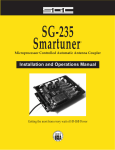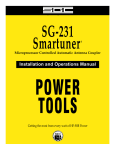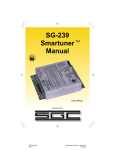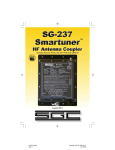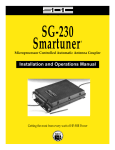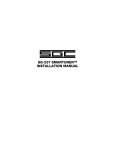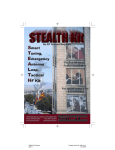Download SGC Go Mobile User`s manual
Transcript
SG-500 SMARTP OWERCUBE™ LINEAR P OWER AMPLIFER User’s Manual SGC, 13737 SE 26th Street Bellevue, WA 98005 USA • Ph: 425-746-6310, Fx: 425-746-6384, Email: [email protected] www.sgcworld.com SGC RESERVES THE RIGHT TO CHANGE SPECIFICATIONS WITHOUT NOTICE Copyright SGC 2007 Table of Contents Warning and Safety Guidelines Page 1 1.0 Introduction Page 2 2.0 Specifications Page 2 3.0 Cautions Page 3 3.1 DC Power Supply Considerations Page 3 3.2 Safety Considerations Page 3 4.0 Antenna Feedline Tips Page 4 4.1 Antenna Characteristics Page 4 4.2 Transmission Feed Lines Page 4 4.2.1 Coaxial Cable and Routing Tips 5.0 Power Supplies Page 5 Page 5 5.1 Battery Power Supplies Page 5 5.2 Alternative Power Sources Page 5 6.0 Front Panel Description Page 6 6.1 RF Out and RF In Jacks Page 6 6.2 Power On/Off Switch Page 6 6.3 Power LED Page 6 6.4 Power Connector Page 6 6.5 Status LED Descriptions Page 7 6.6 Access Connector Page 8 7.0 Amplifier Operation 7.1 Test Transmission Page 9 Page 9 7.2 PTT Keying Page 10 7.3 Mobile Installation Page 10 7.4 SG-500 and SG-235 Interconnection Page 10 7.5 Domestic vs. Export Page 11 8.0 Troubleshooting Guide Page 12 8.1 Fault Analysis Page 12 8.2 Troubleshooting Guidelines Page 12 Test Procedure Page 13 SGC, 13737 SE 26th Street Bellevue, WA 98005 USA • Ph: 425-746-6310, Fx: 425-746-6384, Email: [email protected] www.sgcworld.com SGC RESERVES THE RIGHT TO CHANGE SPECIFICATIONS WITHOUT NOTICE Copyright SGC 2007 SGC SG-500 SmartPowerCube™ User’s Manual, Page 1 Warning! Safety First! The SG-500 SmartPowerCube™ is a high power amplifier capable of producing output power levels which can cause serious RF burns to anyone coming in contact with exposed antenna or feedline during transmission. These RF power levels can also cause fire, explosion, injury or even death resulting from improper or unsafe operation or installation. Observe all rules and precautions of electrical safety and adhere to the operating and installation guidance provided in this manual. Never operate the unit with hits protective cover removed, nor attempt to modify its original circuit design and construction. Doing so may cause malfunctions and void the warranty. Ensure that any work performed on the unit be done in the presence of another person who is thoroughly trained in first aid techniques, including CPR. Power Supply Warning! SGC strongly advises against the use of any switched-mode or analog regulated power supply with the SG-500 amplifier, and doing so may void the product warranty. Regulated analog supplies not designed for use in the high RF fields may experience regulator circuit instability, producing damaging overvoltage conditions, or oscillation between supply and amplifier. To remedy the power supply issue, SGC recommends the use of an unregulated 14 VDC, 50 Amp supply. A lower cost option is to use a 100-Ah lead-acid automotive/RV battery floated with a low cost charger. SGC, 13737 SE 26th Street Bellevue, WA 98005 USA • Ph: 425-746-6310, Fx: 425-746-6384, Email: [email protected] www.sgcworld.com SGC RESERVES THE RIGHT TO CHANGE SPECIFICATIONS WITHOUT NOTICE Copyright SGC 2007 SGC SG-500 SmartPowerCube™ User’s Manual, Page 2 1.0 Introduction The SGC SG-500 SmartPowerCube is a professional grade HF amplifier designed to provide a maximum of 500 watts PEP RF output when driven from virtually any HF transceiver – up to 150 W PEP input. This provides on the air signal levels within 3 dB of a full kW amplifier at a much lower cost. The unit has an operational frequency range of 1.6 to 24 MHz (to 30 MHz for Export version). This amplifier is the result of extensive research and design to create an affordable unit, which provides dependable operation with a minimum of controls and operator interface. The SG-500 is ‘bullet-proof’ – fully protected by microprocessor control. This circuitry dynamically monitors all amplifier parameters and provides adjustments and protection against high VSWR, undervoltage, over-current, and high-temperature conditions. Amplifier status is visible from a row of LED indicators on the front panel. Professional-grade design and construction is utilized through the unit, with all circuit assemblies encased within the massive die-cast alloy chassis/heatsink. PTT Keying Mode and Band Output Filter Selection can be enabled automatically, or by manual control. Band switching time is typically 15 msec or less. This automated capability is ideal for remote or unattended operating site applications. SGC’s conservatively rated amplifier design uses 8 final power transistors for full power output with minimal component stress. The small case dimensions (less than 1 cubic foot) and footprint size allow convenient desktop, mobile, and maritime installation. When used with the matching SG-235 antenna coupler, it forms the heart of an automatic all-band 500 Watt HF system. 2.0 Specifications Power Output: 500 W PEP SSB, 500 W CW 10 min. maximum without fan 500W CW no time limit with fan (at 50% duty cycle) Frequency Range: 1.6 to 24 MHz (1.6 to 30 MHz in export version) Power Input: 50 to 90 Watts (auto) 150 Watts maximum Band Switching: Manual (automatic in export version) Input Voltage: 14.0 VDC (input range 10.0 to 18.0 VDC) Input Current: 40A average (SSB), 90A peak (CW) Cooling: Natural air convection (optional cooling fan available) T/R Switching: 10 msec. nominal Keying: PTT line (manual) or RF sensed (automatic) Protection: Input overdrive, under-voltage, out-of-band frequency input, current imbalance, over-current, over-temperature, high VSWR Built-In Testing: Microprocessor controlled LED fault indicators SGC, 13737 SE 26th Street Bellevue, WA 98005 USA • Ph: 425-746-6310, Fx: 425-746-6384, Email: [email protected] www.sgcworld.com SGC RESERVES THE RIGHT TO CHANGE SPECIFICATIONS WITHOUT NOTICE Copyright SGC 2007 SGC SG-500 SmartPowerCube™ User’s Manual, Page 3 Operating Modes: SSB, CW, RTTY, SITOR, ALE, SSTV, AM at 250 W Dimensions: 4.9” H x 12.0” D x 10.8” W (6.1” H and 13.2”D with feet) (9.75” H with optional fan kit) Case: Solid cast aluminum with matte black powder coat finish Weight: 21 Pounds (9.5 Kg) 3.0 Cautions and Safety Considerations Although you are probably anxious to get your SG-500 amplifier installed into your station and operating, we highly recommend first taking a few moments to review the information presented in this manual. It will help familiarize you with the proper preparation, installation, and operation of your new equipment. The few minutes spent now will save you much time later when you begin the more involved process of installation and getting on the air. 3.1 DC Power Supply Considerations This amplifier is designed to be powered only from a high quality 14.0 VDC power supply providing adequate reserve current capability for the desired operational application. At 500 Watts RF power, high RF and DC current levels are present in and around equipment. We only recommend the use of high quality linear power supplies designed for RF applications. We strongly advise against the use of a switched-mode power supply for high RF application. Permanent damage to the power supply or other station equipment may occur if an improperly designed switched-mode supply is used. It is also best to use a separate, dedicated power supply for the exciter (transceiver). A minimum of 40A, 14VDC is needed for SSB operation and 90A or better for carrier modes (AM, FM, RTTY) or high duty cycle operation. In many cases, a battery can be paralleled or “floated” with a charger or power supply for extended current reserve. However, please check with the manufacturer of the power supply because high-current diodes are sometimes needed to accomplish this. SGC recommends that only a 100-Ah, deep cycle marine/RV battery be used for this application. For commercial or high duty-cycle operation, we recommend installing the optional SGC cooling fan kit for continuous operation. 3.2 Safety Considerations While all SGC equipment is designed with safety and ease of operation in mind, all safety and protective considerations need to be adhered to. Follow the recommended installation instructions outlined later in this manual. The 500 Watt RF energy can cause a painful burn to anyone coming into contact with a radiating antenna element, whip or open transmission line. Ensure that no person or animal comes into direct contact with the antenna or transmission line of your station. SGC, 13737 SE 26th Street Bellevue, WA 98005 USA • Ph: 425-746-6310, Fx: 425-746-6384, Email: [email protected] www.sgcworld.com SGC RESERVES THE RIGHT TO CHANGE SPECIFICATIONS WITHOUT NOTICE Copyright SGC 2007 SGC SG-500 SmartPowerCube™ User’s Manual, Page 4 4.0 Antenna and Feedline Tips The quality of your transmission is directly related to how efficiently you transfer the power from the amplifier to antenna (via the transmission line), and how effectively your antenna radiates your signal into space. Keeping those two facts in mind, we offer the following advice for your station installation. 4.1 Antenna Characteristics Connect your station antenna to the coaxial connector marked RF OUT on the SG-500. Ensure that your antenna is rated to handle a minimum RF power level of 500 Watts PEP or greater, and is resonant at the intended band or frequencies of operation (or being used with an appropriate coupling or tuning device to minimize VSWR). The output impedance of the SG-500 is 50 ohms. Your antenna’s characteristic impedance should present a VSWR of 2.0:1 or less at all desired operating frequencies. When installing the SG-500, you should be absolutely certain that your antenna will handle the power. Because some antenna manufacturers over-rate their antennas, ensure your antenna system is designed for at least 1kW of power. Small antennas that are rated at 500 Watts or less are likely to fail. Also, small antenna systems are subject to component overheating. If this occurs when using the SG-500, immediately investigate and resolve the problem. The antenna system used should have no sharp edges to reduce the possibility of corona discharge, a condition that causes the area around the antenna to glow with bluish-white light. Corona is a very dangerous condition and may lead to fire, destruction of the antenna and damage to the SG-500. When using a wire or metal antenna that has pointed metal parts, please take the time to coat the portions with ‘corona dope’, which is frequently used in the high voltage section of televisions where similar high voltages can occur. The antenna (radiating) wire used with the SG-500 amplifier should be AWG # 8 or heavier, because during transmission high currents exist at certain points on the antenna. These currents may exceed 20 amps (depending upon the impedance at a particular point on the antenna). Electrical theory states that if you try to force 20 Amps through smaller diameter wire, such as AWG # 14, the wire will heat up. Heat translates into lost power. We strongly emphasize that if you have any component heating, you must resolve that issue in order to have the best possible signal. Heat loss = signal loss. 4.2 Transmission Feed Lines You will need to construct or purchase a coaxial jumper cable to connect the transceiver output to the SG500 RF input. Use high quality 50 Ohm foam dielectric cable such as RG-8, RG-8X, or their equivalent. Standard UHF connectors (known as PL-259 plugs) need to be installed at each end. Small diameter RG58 can be used if cable runs are less than three feet. Never use 75 Ohm RG-59 (CATV) cable for this purpose. Use feedline having the lowest loss (per foot) for your application. Although you may use RG-58 type coax for short runs, you should use large coax for lengths over 25 feet. The smaller type of coax cable should not be used because it is subject to the same heating losses as described above. SGC, 13737 SE 26th Street Bellevue, WA 98005 USA • Ph: 425-746-6310, Fx: 425-746-6384, Email: [email protected] www.sgcworld.com SGC RESERVES THE RIGHT TO CHANGE SPECIFICATIONS WITHOUT NOTICE Copyright SGC 2007 SGC SG-500 SmartPowerCube™ User’s Manual, Page 5 4.2.1 Coaxial cable selection and routing tips: A. Transmission line loss varies according to cable age, length, and the frequency of operation. Cables “age” due to time, weather, and UV exposure – all of which may cause the dielectric quality of the insulation between the center conductor and the outer conductor to degrade. Therefore, always select the highest quality coax cable. Review cable specifications and compare outer braid shielding (%), dielectric material, and dB loss per foot across the 1-30 MHz range. In general, the higher the percentage, the better the quality of the outer shield. Two common dielectric materials are polyethylene and foam, with the foam type usually offering better specifications. Transmission line power loss is usually stated in dB per foot, and is proportional to the operating frequency range. The cable offering the lowest loss at 30 MHz or below is best for your HF installation. B. Route the cable as straight as possible, avoiding “kinks” in bends, and coiling excess cable length. Try to distance cable from AC power wiring that may be a source of noise. C. Because high power is involved, all feedline terminations at the transceiver and antenna should be securely fastened. Use solder-type coaxial plugs (sometimes known as PL-259 or UHF connectors) and avoid the crimp or “push-on” solderless type plugs. 5.0 Power Supplies Please read the power supply warning at the front of the manual. The SG-500 is designed to be powered from high quality 14.0 VDC power supply providing adequate reserve current capability for the desired operational application. At 500 Watts, high DC and RF current levels are present in and around equipment. We only recommend the use of high-quality linear power supplies designed for RF applications. A minimum of 40A, 14 VDC is needed for SSB operation and 90A or better for carrier modes (AM, FM, RTTY) or high duty cycle operation. For commercial high duty-cycle operation, we recommend installing the optional cooling fan kit for continuous operation. 5.1 Battery “Float” Power Supply In some cases, a battery can be paralleled or ‘floated’ with a charger or power supply for extended current reserve. However, please check with the manufacturer of the power supply, as high-current diodes in series are sometimes needed to do this. SGC recommends that only a 100-Ah, deep-cycle marine/RV type battery to be used for this application. Note that the power supply may over-charge the battery if left connected when the SG-500 is not in use. Also, if an internal bleeder resistor is used in the power supply, the battery will discharge through it. To prevent either of these situations, remove the positive (+) battery lead when not in use. 5.2 Alternative Power Sources The SG-500 SmartPowerCube may be used with other 14 VDC sources, such as solar and wind power units. However, please ensure that the power source can supply the necessary voltage level and current capacity under load. The amplifier is designed to operate at voltages down to 10 VDC – below this voltage the SG-500 automatically drops ‘off-line’ and is bypassed for SGC, 13737 SE 26th Street Bellevue, WA 98005 USA • Ph: 425-746-6310, Fx: 425-746-6384, Email: [email protected] www.sgcworld.com SGC RESERVES THE RIGHT TO CHANGE SPECIFICATIONS WITHOUT NOTICE Copyright SGC 2007 SGC SG-500 SmartPowerCube™ User’s Manual, Page 6 ‘barefoot’ transceiver operation. 6.0 Front Panel Description This section describes the front panel controls and ports of the SG-500. These are described from left to right. Refer to the drawing above when reviewing the following descriptions. 6.1 RF OUT & RF IN Jacks Connect your station antenna, coupling or tuning device, or manual matching network to the RF OUT jack, and the coax jumper from the exciter (transceiver) to the RF IN jack. Warning: Do not operate the SG-500 without an antenna or suitable dummy load connected. If you are uncertain of the antenna being used, test it at low power before applying 500 Watts to it. The SG-500 test VSWR before bringing the amplifier online. A high VSWR may prevent amplifier operation. 6.2 POWER ON/OFF Switch This powers the SG-500 on/off. When the power switch is in the off position, the amplifier is bypassed, allowing ‘barefoot’ operation. 6.3 POWER LED This LED indicates when 14 VDC power is supplied to the SG-500. 6.4 Power Connector SGC, 13737 SE 26th Street Bellevue, WA 98005 USA • Ph: 425-746-6310, Fx: 425-746-6384, Email: [email protected] www.sgcworld.com SGC RESERVES THE RIGHT TO CHANGE SPECIFICATIONS WITHOUT NOTICE Copyright SGC 2007 SGC SG-500 SmartPowerCube™ User’s Manual, Page 7 This barrier strip with screw terminals allows DC power and RF ground connections. The top screw terminal is for +14 VDC The middle screw terminal is for RF ground. The bottom screw terminal is for DC ground (return). Wiring Tips The +14 VDC wiring should be #6 AWG diameter or larger, and kept as short as possible to avoid excessive voltage drop. The RF ground should be connected to suitable ground system. See other SGC publications for specific antenna ground and counterpoise suggestions. The DC ground / return should also be #6 AWG wire diameter or larger. 6.5 Status LED Description The status LEDs indicate the various amplifier parameters and any fault conditions that may exist. There are two vertical columns of six LEDs. The left column indicates faults and transmit status. The right column indicates the active selected filter band. The function of the various LED indicators are as follows: XMT – When this indicator is on, the amplifier is keyed for transmission. Normally the LED is on only when push-to-talk (PTT) is engaged. CURR – Warns that over-current condition (exceeding 100 A) exists, or if the current imbalance between amplifier modules exceeds 20%. When illuminated, the amplifier has tripped off-line. To reset the amplifier, power down and restart the unit. VOLT – Warns that an under-voltage condition (less than 10 VDC) exists. When illuminated, the amplifier has tripped off-line. To reset the amplifier, power down and restart the unit. IMPORTANT: A common cause of an under-voltage condition is that the power supply does not have sufficient capacity for the power level or duty cycle. A larger power supply or battery-float should be employed. Voltage ‘droop’ under high current demands will not damage the SG-500, but may result in reduced output power. VOLT + CURR – Invalid frequency used. VSWR - Warns that the samples VSWR has exceeded 4:1, and the power reflected back to the SG-500 is higher than acceptable. When illuminated, the amplifier has tripped off-line. To reset the amplifier, power down and restart the unit. VSWR + CURR – Input RF drive level out of range. TEMP – Warns that an over-temperature condition (greater than 55 degrees C) exists. This LED starts flashing at 55 degrees C, and increases in rate until it is on continuously – at which time the amplifier trips off-line. When this occurs, the amplifier has not been damaged and may be operated again as soon as the indicator resumes flashing. Occasional flashing of this indicator SGC, 13737 SE 26th Street Bellevue, WA 98005 USA • Ph: 425-746-6310, Fx: 425-746-6384, Email: [email protected] www.sgcworld.com SGC RESERVES THE RIGHT TO CHANGE SPECIFICATIONS WITHOUT NOTICE Copyright SGC 2007 SGC SG-500 SmartPowerCube™ User’s Manual, Page 8 may occur during normal operation as the temperature of the amplifier rises. KEEP IT COOL: To avoid a high temperature condition, ensure adequate airflow around the unit. Keep the cooling fins unobstructed, and do not stack other station components on the SG-500. If the optional fan is installed, ensure it is plugged in and operating. Also check the VSWR of the antenna system since a high VSWR increases the heat dissipation by the amplifier, causing faster temperature rise. ATTN – This LED indicates the input attenuator circuit is engaged. As input RF power level increases beyond 60-70 Watts, the attenuation increases automatically. The attenuator remains engaged until the input drops to 30 Watts. If this happens, reduce exciter output power slightly. The LED may flash during voice peaks in SSB mode. LOW DRIVE FOR MAX POWER: An illuminated ATTEN LED does not necessarily indicate the amplifier has tripped, or that a faulty condition exists. The SG-500 is designed to be driven to maximum output across either a low (10-60 W) or high (60-150W) input range. This is convenient for transceivers without continuously adjustable output power control. Maximum efficiency occurs when the SG-500 is driven across the “low” input range, just below the point where the attenuator circuit is activated. ALC – ALC control provides adjustable ALC feedback voltage available via pin #3 (ALC) of the ACCESS connector. This provides a positive ALC voltage range of approximately 1-5 VDC and should not be used with transceivers utilizing negative ALC control. BAND FILTER SELECT – These LEDs indicate which of the input band-pass filters are active, as selected via manual or automatic control. BAND 1 BAND 2 BAND 3 BAND 4 BAND 5 BAND 6 LED is on when the 1.6 – 2.2 MHz filter is selected LED is on when the 2.2 – 4.2 MHz filter is selected LED is on when the 4.2 – 7.7 MHz filter is selected LED is on when the 7.7 – 13.2 MHz filter is selected LED is on when the 13.2 – 23.3 MHz filter is selected LED is on when the 23.3 – 30 MHz filter is selected *Note – BAND 6 selection is disabled on US/Domestic version amplifiers. Licensed amateur and commercial station operators may restore full coverage by following the procedure outlined in section 7.5 of this manual. 6.6 ACCESS Connector Inserted into the ACCESS connector is the supplied 10 pin vertical plug which permits interfacing to certain amplifier functions. Below this is a three pin horizontal connector controls the optional cooling fan unit (SGC part number #51-82) Access connector pins (from top to bottom) are described below: 14 VDC – switched 14 VDC via the ON/OFF switch is present on this line (maximum 5A). Not to be used for powering station components drawing greater than 5A. GND – Chassis ground for control purposes available on this line. SGC, 13737 SE 26th Street Bellevue, WA 98005 USA • Ph: 425-746-6310, Fx: 425-746-6384, Email: [email protected] www.sgcworld.com SGC RESERVES THE RIGHT TO CHANGE SPECIFICATIONS WITHOUT NOTICE Copyright SGC 2007 SGC SG-500 SmartPowerCube™ User’s Manual, Page 9 PTT – Push-to-talk control. This keys the amplifier circuitry when this line is grounded, and the PTT control switch is set to manual. ALC – Automatic Level Control. A positive-going voltage is present on this line for use with transceivers equipped for ALC input control. See the ALC control description. BAND 1 – BAND 6 – Bringing the appropriate line low (to ground) selects the desired input filter for domestic operation when the front-panel FILTER SELECT switch is set to MANUAL. A simple rotary switch box can be constructed for this purpose. With the FILTER SELECT switch set to AUTO (for Export use), input filters are selected automatically each time you key the exciter. FAN – The optional cooling fan (SGC PN #51-82) cable plug inserts into this connector for power and fan control. 7.0 Amplifier Operation This section intends to get you on the air using your new amplifier with maximum ease. Before starting, check the following items. • Ensure you are using a DC power source capable of providing at least 14 VDC at 40A or greater. Do not run the amplifier and transceiver from the same supply. • Check that the power cables are firmly terminated at the power strip on both the amplifier and power supply. The screws should be firmly tightened so that the cable lug terminals are flat against the strip for best mechanical and electrical contact. • Ensure the amplifier, transceiver (and any other station components such as the SG-235, or manual antenna coupler) are connected to a proper RF grounds. 7.1 Test Transmission Start by testing into a 50-ohm RF dummy load connected into the RF OUT jack on the SG-500. We recommend installing a RF power meter in-line to monitor your transmitted output power. NOTE: You cannot perform this test with a 40A power supply. a. Set the PTT and FILTER select switches on the front panel to AUTO, and turn the power on. The red LED should light. b. Select CW mode on your transceiver, and reduce the power output control to minimum. Note: other carrier modes (AM or FM) can be used if your transceiver does not have CW capability. c. Set the transceiver drive for 25W in CW mode. Turn the amplifier on and switch the radio to voice, do a test count, and check that the power peaks on the meter. Turn the amplifier off, reset the transceiver to 35W in CW and repeat voice test. When the voice peaks begin to activate the attenuator, you have passed the best level. Reduce the drive in 5W increments until the attenuator does not activate on voice peaks. d. Re-adjust the power output control just below the “break-point” (the top of the input range before the ATTEN circuit activates). You have now found the “sweet spot” at which you can drive the amplifier to maximum output with minimum drive. This is the recommended drive method to be used whenever practical. SGC, 13737 SE 26th Street Bellevue, WA 98005 USA • Ph: 425-746-6310, Fx: 425-746-6384, Email: [email protected] www.sgcworld.com SGC RESERVES THE RIGHT TO CHANGE SPECIFICATIONS WITHOUT NOTICE Copyright SGC 2007 SGC SG-500 SmartPowerCube™ User’s Manual, Page 10 e. Now switch the transceiver to SSB, and transmit in a normal voice. The ATTEN circuit should not activate, except on occasional voice peaks. (This concludes the test transmission. You can now connect your station antenna and any other interconnections.) INPUT DRIVE LEVELS: The amplifier reduces power when the ATTEN circuit activates, and then must be driven through a higher input range to derive maximum output. Some 100-watt class amateur transceivers may not be capable of producing sufficient output levels to drive the SG-500 for maximum output. Therefore, as stated before, we recommend using the low input range (10-50 Watts) for normal operation. 7.2 PTT KEYING: AUTO vs. MANUAL The amplifier can be keyed either manually or automatically – the best method will depend on your preference or application. Please note that whenever either PTT or Filter switches are changed, you must turn the power off and back on to acknowledge the change. Manual Keying – This requires a wire connection to your transceiver; the PTT line (on the ACCESS connector) needs to be pulled low (to ground) when your transceiver is keyed to transmit. This is the preferred configuration to be used. Check with the documentation provided with your particular transceiver for details on where to access this connection. Note: In manual PTT and Auto Filter mode, there will be a 10-15 msec delay while the CPU measures the frequency and selects the correct filter band. Automatic Keying – This uses RF sensing to detect when you transmit, and then brings the amplifier online. Although automatic keying requires no control line, a small associated delay may be encountered in SSB mode due to the “rise time” characteristic of SSB modulation. 7.3 Mobile Installation of the SG-500 If you are operating the amplifier mobile, please remember that the minimum size wire to be used from the battery to the amplifier is AWG #6. Heavier wire is preferred. The recommended way to install the amplifier in mobile installations is to install a second battery next to the amplifier. Operating HF mobile at the 500 watt level requires careful planning and understanding of RF and automotive systems. The information needed regarding this is too expansive to be adequately dealt with here in this manual. In response to customer inquiries, and from invaluable knowledge gained in this area by SGC research staff, SGC offers a highly informative publication called “Go Mobile at 500 Watts” which outlines the complete installation process in a variety of vehicles. This book is available for free download from our website at www.sgcworld.com. 7.4 SG-500 and SG-235 Interconnections When the SG-500 is used with the SG-235 Smartuner™, they form the heart of an outstanding 500 watt automatically tuned HF system. Interconnections between the SG-500 and SG-235 permit amplifier keying only when a proper antenna impedance match has been found. Only a few connections need to be SGC, 13737 SE 26th Street Bellevue, WA 98005 USA • Ph: 425-746-6310, Fx: 425-746-6384, Email: [email protected] www.sgcworld.com SGC RESERVES THE RIGHT TO CHANGE SPECIFICATIONS WITHOUT NOTICE Copyright SGC 2007 SGC SG-500 SmartPowerCube™ User’s Manual, Page 11 made between these components, as outlined below: SG-235 Coaxial cable plug Yellow wire Blue wire White wire SG-500 RF out jack PTT line (pin #4) Smartlock Pro Blue wire White wire Please refer to the SG-235 manual for further coupler wiring details. Remote ON/OFF Power Control: The SG-500 can be turned on/off remotely via a connector provided for this purpose. To the left of the front panel PTT selection switch is a vertical 4-pin header. A jumper comes installed across the top two pins, which are in series with the front-panel ON/OFF switch line. The bottom two pins provide indicator output for a LED, and are in parallel with the front panel PWR LED. SGC provides a Remote Control box for the amplifier that can be purchased separately (Cat. #52-88). To install a custom remote on/off switch, remove the upper jumper and connect your switch leads in its place using a push-on connector. Likewise, a remote LED can be connected to the lower two pins if desired (LED ground connection on the lower pin). Leave the front panel on/off switch in the ON position to enable your remote line in this configuration. 7.5 DOMESTIC vs. EXPORT Amplifier Versions Amplifiers manufactured for US domestic sales are disabled to operate above 24.5 MHz, Export versions of the SG-500 do not have this restriction. Amateur radio, MARS, or CAP operators holding valid, current FCC station licenses may operate the SG-500 on US amateur bands above 24.5 MHz or other frequencies, limited to the operating privileges authorized in their license (see the warning and disclaimer below). This requires performing and equipment modification. The instructions for the modification can be found under the ‘Technical Notes’ section of the SGC website. Modification Warning and Disclaimer: Intentional modification and use of this amplifier for operation in domestic radio services not authorizing output power levels for which this amplifier is designed or type-approved may be in violation of FCC regulations. Furthermore, operators convicted of such violations may be subject to legal fines, forfeiture/revocation of station license, and or equipment confiscation. SGC assumes no responsibility nor liability for an unapproved or unauthorized circuit modification to the amplifier. Any such modifications are performed against the manufacturers recommendations solely at the user’s own risk, and will void the limited warranty. SGC, 13737 SE 26th Street Bellevue, WA 98005 USA • Ph: 425-746-6310, Fx: 425-746-6384, Email: [email protected] www.sgcworld.com SGC RESERVES THE RIGHT TO CHANGE SPECIFICATIONS WITHOUT NOTICE Copyright SGC 2007 SGC SG-500 SmartPowerCube™ User’s Manual, Page 12 8.0 Troubleshooting Guide The information presented in this manual attempts to cover the most commonly encountered questions and difficulties in HF station installations. However, conditions may arise when one or more components in your station may not function properly, causing the amplifier to not operate. 8.1 Fault Analysis A solid understanding station interconnections and equipment specifications helps in resolving the problem. The following table analyzes common faults and their correction: FAULT CURR trip off-line VOLT trip off-line VSWR trip off-line TEMP LED flashing No PTT Keying ADVICE Ensure power supply maintains voltage greater than 11.0VDC under load. Check DC cable connections. Use only #6AWG wire or heavier and make cable lengths as short as possible. Check batter charge state and voltage droop under load. Use separate supplies for amp and transceiver. Reduce input drive level. Check integrity of antenna and feedline connections. Check for evidence of arc-over or dielectric breakdown of feedline. Ensure antenna is resonant (<2:1 SWR) at the desired operating frequency. Check proper interconnection and operation of the SG-235 or manual matching network. Reduce drive level or duty cycle. Ensure fan unit is operating by checking FAN plug on front panel ACCESS connector, or supply forced cooling to lower heatsink temperature. Ensure transceiver, amplifier and DC supply all utilize a common ground return. Use externally-switched relay for PTT line control. Please note that the SG-500 represents the latest in microprocessor control technology, and the amplifier is designed to shut off in the event that any critical parameter is outside pre-determined values. This insures that the amplifier will give many years of maintenance-free service and optimum performance. This also means that particular attention must be given to the amplifiers environment and associated systems. Most particular, the power supply and antenna. The next section addresses specific troubleshooting steps to isolate a fault experienced with the amplifier. 8.2 Troubleshooting Guidelines SGC has determined that many reports of amplifier ‘difficulties’ actually stem from problems relating to the power supply voltage, interconnection cables, and antenna installations. If a quick review of your installation and the above table does not provide solution, we advise making the following checks before contacting SGC for technical support: SGC, 13737 SE 26th Street Bellevue, WA 98005 USA • Ph: 425-746-6310, Fx: 425-746-6384, Email: [email protected] www.sgcworld.com SGC RESERVES THE RIGHT TO CHANGE SPECIFICATIONS WITHOUT NOTICE Copyright SGC 2007 SGC SG-500 SmartPowerCube™ User’s Manual, Page 13 TEST PROCEDURE 1. Connect a 50-ohm RF dummy load (1 KW rating) to the amplifier output jack, and an inline wattmeter (0-200 watt range) between the transceiver and the amplifier. 2. Connect an in-line wattmeter (0-1000 watt range) between the amplifier output jack and the RF dummy load. 3. Select CW mode, and adjust the transmitter output power level to 40 watts. 4. Turn on the SG-500, and transmit. Confirm that a CURR/VOLT fault does ( ) or does not ( ) occur. 5. If a fault occurs, use an analog DC voltmeter to measure the voltage at the amplifier DC terminal under load (TX): _______ and idle (RX):________ 6. Confirm that a VSWR fault does ( ) or does not ( ) occur. 7. If a fault occurs, discontinue testing and contact SGC. 8. If no fault occurs, check your antenna, antenna coupler interconnections, transmission line, and measure overall system SWR: _______ @ _____ MHz. 9. If the SWR is 2.0 : 1 or less, you may test your system on the air. If further problems persist, contact SGC for technical support. Be prepared to provide the serial number of your unit and the information above. SGC, 13737 SE 26th Street Bellevue, WA 98005 USA • Ph: 425-746-6310, Fx: 425-746-6384, Email: [email protected] www.sgcworld.com SGC RESERVES THE RIGHT TO CHANGE SPECIFICATIONS WITHOUT NOTICE Copyright SGC 2007















